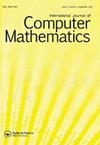On the simultaneous reconstruction of the initial diffusion time and source term for the time-fractional diffusion equation
IF 1.3
4区 数学
Q2 MATHEMATICS, APPLIED
International Journal of Computer Mathematics
Pub Date : 2023-09-21
DOI:10.1080/00207160.2023.2260011
引用次数: 0
Abstract
AbstractFacing application in real world, a simultaneous identification problem of determining the initial diffusion time (or the length of diffusion time) and source term in a time fractional diffusion equation is investigated. First the simultaneous reconstruction problem is proposed by translating the Caputo fractional derivative. Then the uniqueness results for the simultaneous identification problem are proven by the technique of analytic continuation and the Laplace transformation method. Next the Lipschitz continuousness of the observation operator is derived, and an alternating direction inversion algorithm is proposed to solve the simultaneous identification problem. At last, several numerical examples are computed to show the efficiency and stability of the reconstruction algorithm.Keywords: Simultaneous identificationthe length of diffusion timeinverse source problemuniquenesstime-fractional diffusion equation2000 MR Subject Classification: 65M0665M1265M32DisclaimerAs a service to authors and researchers we are providing this version of an accepted manuscript (AM). Copyediting, typesetting, and review of the resulting proofs will be undertaken on this manuscript before final publication of the Version of Record (VoR). During production and pre-press, errors may be discovered which could affect the content, and all legal disclaimers that apply to the journal relate to these versions also. AcknowledgmentsThis work is supported by National Natural Science Foundation of China (12061008, 11861007, 11961002), Natural Science Foundation of Jiangxi Province of China (20202BABL 201004).时间分数扩散方程初始扩散时间和源项的同时重建
摘要面对实际应用,研究了时间分数阶扩散方程中初始扩散时间(或扩散时间长度)和源项的同时辨识问题。首先,通过卡普托分数阶导数的平移,提出了同步重构问题。然后利用解析延拓技术和拉普拉斯变换方法证明了该问题的唯一性结果。其次,推导了观测算子的Lipschitz连续性,并提出了一种交替方向反演算法来解决同步识别问题。最后,通过算例验证了重构算法的有效性和稳定性。关键词:同时识别扩散时间长度逆源问题唯一性时间分数扩散方程2000 MR主题分类:65m0665m1265m32免责声明作为对作者和研究人员的服务,我们提供此版本的接受稿件(AM)。在最终出版版本记录(VoR)之前,将对该手稿进行编辑、排版和审查。在制作和印前,可能会发现可能影响内容的错误,所有适用于期刊的法律免责声明也与这些版本有关。国家自然科学基金(12061008,11861007,11961002)和江西省自然科学基金(20202BABL 201004)资助。
本文章由计算机程序翻译,如有差异,请以英文原文为准。
求助全文
约1分钟内获得全文
求助全文
来源期刊
CiteScore
3.60
自引率
0.00%
发文量
72
审稿时长
5 months
期刊介绍:
International Journal of Computer Mathematics (IJCM) is a world-leading journal serving the community of researchers in numerical analysis and scientific computing from academia to industry. IJCM publishes original research papers of high scientific value in fields of computational mathematics with profound applications to science and engineering.
IJCM welcomes papers on the analysis and applications of innovative computational strategies as well as those with rigorous explorations of cutting-edge techniques and concerns in computational mathematics. Topics IJCM considers include:
• Numerical solutions of systems of partial differential equations
• Numerical solution of systems or of multi-dimensional partial differential equations
• Theory and computations of nonlocal modelling and fractional partial differential equations
• Novel multi-scale modelling and computational strategies
• Parallel computations
• Numerical optimization and controls
• Imaging algorithms and vision configurations
• Computational stochastic processes and inverse problems
• Stochastic partial differential equations, Monte Carlo simulations and uncertainty quantification
• Computational finance and applications
• Highly vibrant and robust algorithms, and applications in modern industries, including but not limited to multi-physics, economics and biomedicine.
Papers discussing only variations or combinations of existing methods without significant new computational properties or analysis are not of interest to IJCM.
Please note that research in the development of computer systems and theory of computing are not suitable for submission to IJCM. Please instead consider International Journal of Computer Mathematics: Computer Systems Theory (IJCM: CST) for your manuscript. Please note that any papers submitted relating to these fields will be transferred to IJCM:CST. Please ensure you submit your paper to the correct journal to save time reviewing and processing your work.
Papers developed from Conference Proceedings
Please note that papers developed from conference proceedings or previously published work must contain at least 40% new material and significantly extend or improve upon earlier research in order to be considered for IJCM.

 求助内容:
求助内容: 应助结果提醒方式:
应助结果提醒方式:


